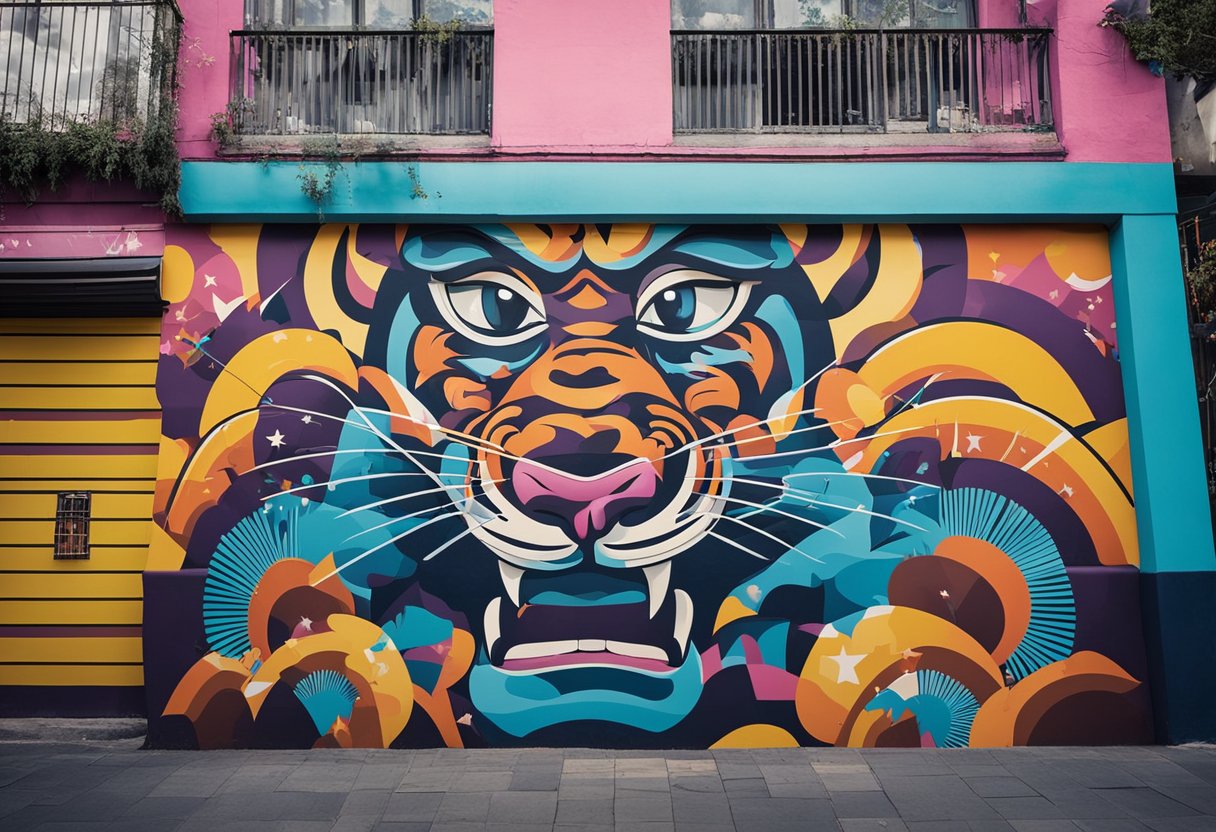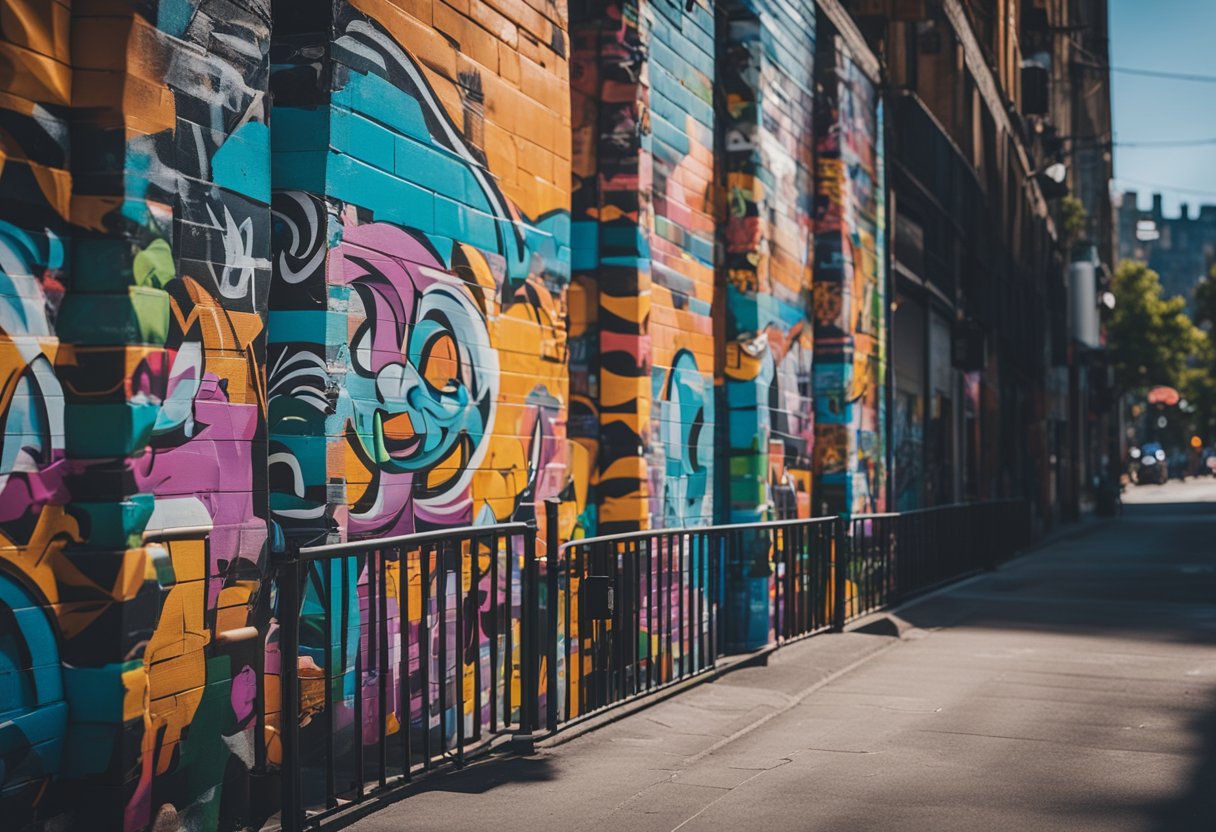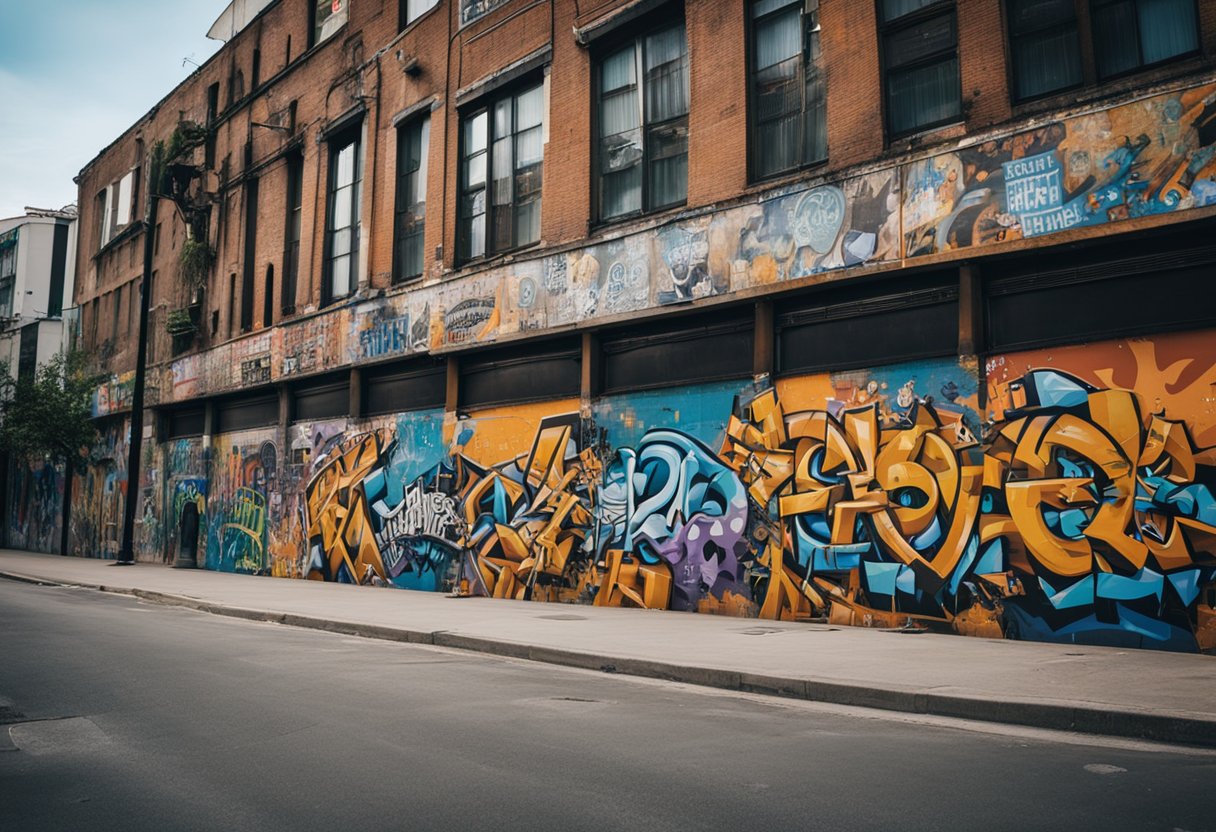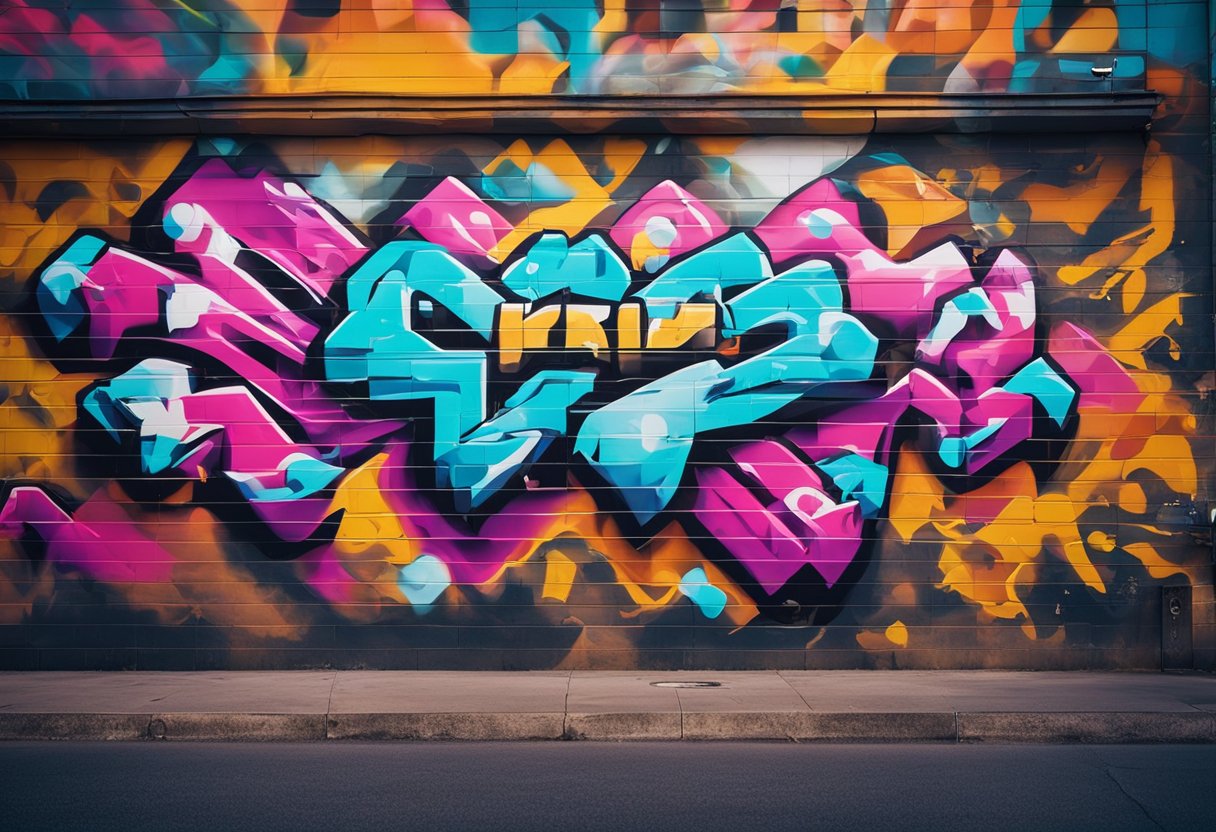The World of Street Art: Exploring the Global Urban Canvas and its Cultural Impact

Updated On: March 28, 2024 by Maha Yassin
Street art is a dynamic expression that bathes urban landscapes in vibrant colours and thought-provoking imagery. Around the world, these visual narratives function not only as a means of personal expression for the artists but also as a reflection of social and cultural currents within communities. From the historic alleyways of Europe to the bustling streets of South America, every piece of street art is a chapter in the larger story of human experience, capturing the pulse of various societies.
As a compelling medium transcending language, street art communicates with a broad audience, delivering messages ranging from political protests to heritage celebrations. This urban canvas is ever-changing, with new works appearing and older ones fading, echoing the fluid nature of city life itself. Artists utilise many techniques and styles to leave their mark, melding traditional methods with innovative practices. The result is a rich tapestry of aesthetic diversity that challenges viewers to engage with the art deeper, prompting reflection, dialogue, and, at times, action.
The Essence of Street Art
Street art has transformed the urban landscape into a vibrant tapestry of expression and dialogue. Once considered a form of vandalism, it has evolved into a legitimate and powerful art form, resonating deeply with culture and identity.
Graffiti, the early precursor to today’s multifaceted street art, etched its marks on city walls as an act of visibility, a claim to existence in a rapidly changing urban reality. These visual declarations ranged from personal taggings to elaborate pieces, setting the stage for an urban art revolution.
The essence of street art lies in its ability to converse with the public without the barriers of traditional art venues. It invites passersby to pause and reflect, engaging with themes of social commentary and giving a voice to the voiceless. This art is often temporary, weathering over time or being covered by new layers of paint, adding to its transient beauty and immediacy.
Amid the concrete jungles, these impromptu canvases reflect societal moods, often encapsulating local and global issues. From the silent whispers of a stencil to the loud clamour of a mural, street art speaks volumes about the times and places it inhabits, making it a potent force in shaping our shared urban identity.
It’s not just about aesthetics; street art has a role in beautifying and reclaiming spaces, turning bland facades into messages of hope, resistance, and humanity. Each piece serves as a cultural artefact, a snapshot of creativity as diverse as the communities it emanates from. Ours is a world where street art is a visual dialect for all to engage with.
Historical Evolution of Urban Art
We’re about to explore the fascinating progression of urban art from ancient times to the iconic artists that have defined its contemporary form.
Ancient Origins to Modern Movements
Urban art possesses a rich heritage that can be traced back to ancient civilisations. Chiselled etchings and painted walls were an integral way through which cultures such as Rome and Egypt immortalised their existence. Fast forward to the 20th Century, and urban environments became the canvases for graffiti and pop art. This era marked the transition from ancient expressions to modern movements, with the advent of graffiti intertwined with the rise of hip-hop culture.
During the 1970s, figures such as Taki 183 – a messenger from the streets of New York – became legendary for their tagging, prompting a wave of street art across urban spaces. Intersecting with music, fashion, and language, street art began to mirror the rhythm and voice of the disenfranchised, as well as the vibrancy of the ever-changing city.
The Rise of Iconic Street Artists
In the 1980s, artists like Keith Haring and Jean-Michel Basquiat emerged, bringing street art from the subway stations and alleyways into the art galleries. Their rich historical perspective work expanded the framework of what was considered art.
Soon, historians and lovers of art history would witness the evolution of urban art as it grew to include stencil art, with Banksy becoming the enigmatic face of this realm. Along with Shepard Fairey’s iconic “OBey” campaign, stencil art became a global phenomenon, harnessing the essence of societal and political discourse.
Our immersion into urban art is one of discovery, tracing lines back centuries and spiralling towards an array of modern, influential voices. Each piece offers insight into the artist’s psyche and the cultural and historical consciousness of our urban landscapes.
Techniques and Styles
We explore the sophisticated array of techniques and styles that constitute the eclectic world of street art, focusing on how artists convey powerful messages through the urban canvas.
Graffiti and Tagging
Graffiti primarily incorporates stylised lettering and design, often featuring vibrant colour schemes that splash across cityscapes. It starts with the simple tag, an artist’s signature synonymous with their identity. Artists expand upon this with intricate, wild styles that intertwine characters with interlocking letters and shapes, pushing the boundaries of typography and visual flow.
Stencilling and Murals
In contrast, stencilling applies a cut-out design to produce a clear, replicable image or pattern. Due to their visibility and size, these usually deliver bolder political or social statements. Murals, meanwhile, transform large walls into stunning, story-laden masterpieces imbued with character and local narratives, often becoming celebrated landmarks within communities.
Installations and Urban Interventions
Street installations transcend traditional two-dimensionality, incorporating three-dimensional works and repurposing urban elements into thought-provoking pieces. Whether it’s yarn bombing or hijacking street signs, these installations create surprise and intrigue, inviting passersby to interact with their environment in new ways. Urban interventions go a step further, often reclaiming public spaces to challenge the status quo or societal norms.
Cultural and Social Impact
As we explore the vibrant world of street art, it’s essential to recognise its substantial role in conveying cultural and social narratives. Our observations of this dynamic art form provide insights into how street art is a powerful platform for social commentary and activism within urban landscapes.
Street Art as Social Commentary
We often witness street art that holds a mirror up to society, reflecting the ongoing social issues within our communities. These artistic expressions tackle social justice, economic disparity, and cultural identity, offering bold and unfiltered perspectives on our urban reality. For instance, street art has become a visual dialogue about social messages, illustrating struggles and triumphs that resonate with many. By occupying public spaces, these artworks become accessible to a wide audience, igniting conversations and challenging viewers to engage with pressing topics of our times.
Activism and Political Messages
Street artists’ brushstrokes and spray paints frequently address political messages, with murals and stencils becoming a canvas for rebellion against injustice. From advocating for equality to questioning governmental policies, street art has raised awareness and sparked change. We’ve seen how such art can promote pride and solidarity among community members, galvanising support for causes and moving people toward collective action. Furthermore, activism through street art fosters community engagement. It transforms urban spaces into hubs of cultural discourse, serving as artistic displays and as rallying points for civic participation.
Community and Identity

Street art has become a powerful medium for expressing community pride and cultural identity within urban landscapes. This visual communication allows local communities to publicly voice their uniqueness and shared values. Murals and graffiti often reflect the local customs and heritage, bridging the gap between generations and fostering a renewed sense of belonging.
- Understanding Through Art: By encountering these artworks daily, residents and visitors gain insights into what makes a neighbourhood distinctive.
- Visual Stories: Each piece serves as a narrative, telling stories of the area’s past and present and sometimes hopes for the future.
In many cases, the very act of creating street art is a communal effort involving residents and artists alike. This collaboration strengthens communal bonds and affirms the neighbourhood’s identity. Moreover, street art can transform an ordinary urban environment into an open-air gallery accessible to all, promoting inclusivity and a democratic use of space.
Street art in various localities can instil pride within a community as they witness and participate in beautifying their surroundings. It is not uncommon for street art to become a landmark within a neighbourhood, symbolising its culture and providing a canvas that continuously evolves with the community.
While some may see street art as mere decoration, transformative works reflect cultural identity through vivid imagery that resonates with the residents. We see a fusion of creativity that mirrors the dynamics of our cities – a harmonious urban symphony of visuals speaking to all who wander through the streets.
Geographical Spread and Local Flavours

Street art has transformed urban environments into galleries that showcase diverse cultural expressions. It fuses local traditions with global trends, creating a visual dialogue that spans continents.
Global Art Form
Street art is a dynamic art form that exists in nearly every major city around the globe. From the graffiti-tagged alleys of North America to the vibrant murals that grace the streets of South America, it reflects the pulse of urban life. In Europe, street art adds a contemporary layer to historic cities, while in Asia and Africa, it often intertwines traditional motifs with modern narratives. Brazilian twins Os Gêmeos are prime examples of how artists meld global influences with regional aesthetics, earning worldwide acclaim for their colourful and surrealistic style unique to Brazilian culture.
Cultural Icons and Regional Styles
Each urban canvas reveals insights into cultural icons and regional styles. In Europe, particularly in London, street artists channel the city’s rich history into their work, often commenting on contemporary societal issues. Moving across to Africa, local traditions are communicated through art, with many pieces focused on community life and social identity. Within Asia, the spread of street art reflects both the rapid modernisation of cities and the preservation of Asian philosophies. It’s a blend of the old and the new, a testament to these diverse cultures’ resilience and evolving identities.
Economic and Political Factors

In the intricate tapestry of urban environments, street art emerges as a medium where economic and political narratives collide, challenging notions of property and authority to offer a potent display of sentiment and activism.
Public Spaces and Ownership
We witness in public spaces an ongoing tussle over ownership. Street art, inherently public, typically occupies spaces that city entities or private individuals legally own. This space occupation fuels a debate on the rights of artists versus those of the owners. Street art adds economic value by promoting tourism and local businesses, as discussed in “Street art/art in the street – semiotics, politics, economy”, but simultaneously can incite legal confrontations over property rights.
Art, Vandalism, and City Officials
The delicate boundary between art and vandalism is often navigated by city officials, who must balance fostering creative expression and upholding the law. While street art can convey powerful messages and enhance the visual landscape, instances deemed vandalistic can attract penalties and spark political discourse. The intervention of authorities often illuminates the politics involved, especially when seeking to push boundaries within the urban canvas, which is further explained through such dynamics revealed in “Exploring the Political Messages in Street Art – Street Buddha”. This interaction underlines the complexity of managing urban aesthetics and free speech by those in governance.
Intersection with Other Art Forms
As we explore the rich tapestry of street art, we find it weaving its way into various aspects of our visual and cultural landscape, significantly influencing pop culture and fashion and transitioning from outdoor urban canvases to the esteemed galleries of the art world.
Influence on Pop Culture and Fashion
The vibrant language of street art has made a lasting impact on pop culture. This art form often carries bold political and social commentary that resonates with a wide audience, and its aesthetics have been absorbed into the designs and motifs of contemporary fashion. Fashion designers have reinterpreted iconic elements of graffiti and pop art to create clothing lines that embody the rebellious spirit of the streets, thereby solidifying street art’s position as a global art form.
Street art’s vivid visual vocabulary has been incorporated into the merchandising of music artists, often blurring the lines between commercial and counterculture. This fusion can be seen in album covers, music videos, and even on-stage performances, showcasing how other creative sectors have embraced street art and left its indelible mark on the broader canvas of pop culture.
From Street to Gallery
Street art’s journey from the alleys and subways to the polished floors of galleries is a testament to its evolution as a respected art form. Once viewed as vandalism, it is now celebrated for its audacious creativity and powerful expression. Galleries and exhibitions now diligently curate street art, bringing it to a wider audience and granting it a legitimacy that has fostered dialogue between the urban streets and the traditional art establishment.
As cultural observers witness breathtaking murals and stencils transition into framed pieces within a gallery, we appreciate the transformation of perception surrounding street artists. They are now recognised as contemporary masters, their works commanding significant attention and value in the art market. This transition not only highlights the fluidity of art but also showcases the undeniable prowess of street artists in mastering both the spontaneity of street walls and the curated environment of galleries.
Innovators and Pioneers
We recognise the streets as more than mere pathways; they serve as a canvas for some of the most influential artists of the urban art scene. The movement has nurtured legends whose works have transcended the confines of the conventional gallery and embedded themselves into the fabric of urban landscapes. At the forefront of this movement are names that have pioneered the art form and continue to inspire new generations.
Banksy, an enigmatic figure, expertly weaves social commentary and satire into his pieces, making them some of the most recognisable works worldwide. Another notable figure, Shepard Fairey, rose to fame with his “Obey Giant” campaign and solidified his place in street art history with the iconic “Hope” poster during Barack Obama’s presidential campaign.
Alternatively, Invader draws from popular 8-bit video games to tile cities with nostalgic mosaics. As for Blu, his large-scale murals often provide a stark commentary on political and environmental issues. Meanwhile, JR utilises his camera to turn residents into monumental artworks, challenging traditional perceptions of portraiture.
| Pioneers | Known For |
|---|---|
| Ron English | Bold lines and vivid colours, engaging accessible imagery. |
| Futura | Abstract approach and influence on graffiti’s direction. |
| Jean-Michel Basquiat | Raw imagery blending poetry, painting, and commentary. |
| Keith Haring | Bold lines and vivid colors, engaging accessible imagery. |
| TAKI 183 | The godfather of graffiti, igniting the tagging movement. |
Highlighting the lineage of innovation, Jean-Michel Basquiat emerged from the gritty New York scene and, alongside Keith Haring, bridged the gap between street and high art with his visceral, primitive scrawls and energetic figures. Not to be overlooked, TAKI 183’s simple act of tagging his moniker across NYC ushered in a new graffiti era.
Our journey through the urban landscape reveals a rich tapestry of expression, where each pioneer’s contribution has carved an indelible mark upon the walls of our cities and the annals of art history. Their messages persist, compelling us to observe, reflect, and engage with the world around us.
Conservation and Preservation
The very essence of street art lies in its ability to communicate powerful messages through vivid murals that transform urban landscapes into a mosaic of expressions. However, the conservation and preservation of these works pose significant challenges. With the beautifying impact they have on otherwise drab cityscapes, it’s essential to maintain their colour and vibrancy.
- Environmental Concerns: The materials used in street art can fade over time due to environmental factors such as pollution and sunlight. Protective coatings and regular maintenance can help preserve the brilliance of these urban masterpieces.
| Factor | Concern | Mitigation |
|---|---|---|
| Sunlight | It can cause fading and deterioration of pigments. | Use of UV-resistant sealants. |
| Pollution | May lead to discolouration and chemical damage. | Regular cleaning and anti-graffiti coatings. |
| Vandalism | Destruction or defacing of murals. | Community surveillance and involvement. |
- Iconic Landmarks: Many murals become landmarks in their own right, representing iconic figures or historical events that resonate with the local community. These artworks require rigorous methods that address the piece’s physical upkeep and original intent.
We recognise that each mural holds its narrative, contributing to the collective story of our urban canvas. Through concerted efforts in conservation, these landmarks can continue to enchant onlookers and offer commentary on our society.
Preservation efforts are not only a mechanism to protect; they also reflect a commitment to the cultural significance of street art. As these artistic displays face the threat of erosion over time, we are responsible for safeguarding them for future generations, ensuring that the messages they bear persist amidst the ever-changing face of our urban environments.
Influence of the Digital Era

The digital era has seamlessly blended with the texture of urban life, transforming street art’s outreach and methodology. The visual narratives of street artists now resonate beyond physical boundaries, capturing the essence of self-expression and social commentary.
Street Art and Social Media
Social media has magnified the impact street artists can have on urban culture. Once limited to the eyes of locals or passersby, a single mural can now journey across the globe in seconds. Platforms like Instagram have become galleries where street art gains momentum, with each post amplifying messages that often address the very nuances of urban life. The interplay between these visual spectacles and digital audiences fosters a novel online community that thrives on the ‘share and tag culture.’ This communal aspect also serves as a digital ledger, documenting the transient nature of street art, which is often at the mercy of the environment or city ordinances.
Digital Techniques and Online Communities
Adopting digital techniques, artists wield new tools to craft their creations. Software such as Photoshop and Illustrator nurture the translation of street art from concrete to digital canvas, forging avenues for innovation and intricate designs. Like other creatives, street artists join online communities that bolster collaboration and offer platforms for critique and appreciation. Here, artists can exchange ideas, methods, and projects that might be impossible in isolation. The digital age, therefore, is not merely a backdrop but an active catalyst that shapes how self-expression evolves and interacts with the sprawling canvas of the city.
FAQs
In this section, we address some of the most pressing questions about the evolving landscape of urban street art, from its iconic masterpieces to the nuances of its legality.
What are the most iconic street art pieces, and where can they be found?
Iconic street art, such as Banksy’s ‘Girl With Balloon’ in London or ‘Hope’ by Shepard Fairey in the United States, can be seen worldwide. These pieces have left indelible marks on the cities where they reside, often sparking conversations about art and society.
How does street art contribute to political and social discourse?
Street art plays a significant role in voicing opinions on political and social issues, offering an unfiltered canvas for artists to address topics such as inequality, war, and environmental concerns, thus sparking public debate and potentially inspiring change.
In what ways has street art been commercialised in recent years?
The commercial sector has recently embraced street art, with artists collaborating with brands, creating product designs, or being represented by galleries, transforming the once-rebellious form into a recognised and marketable aspect of contemporary art.
What legal considerations exist for artists creating street art?
Legal issues can be complex; street artists must navigate copyright laws, potential charges of vandalism, and the need for property owners’ permissions, which also vary significantly from city to city and country to country.
How has the public perception of street art changed over time?
Public perception of street art has shifted considerably, with many now viewing it as a legitimate art form rather than an act of vandalism. This cultural shift has been reflected in the increased protection of street art and the inclusion of murals in urban development plans.
Which techniques and materials are commonly used by street artists?
Street artists commonly utilise spray paint, stencil, sticker art, and poster-making techniques. Some might also incorporate multimedia and unconventional materials, reflecting the innovative spirit and adaptability of the street art movement.






